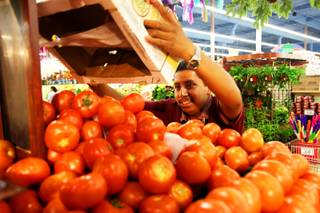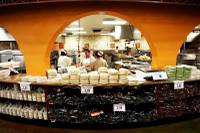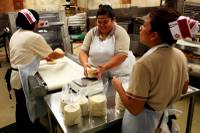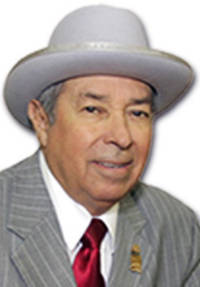IN THIS ISSUE OF VEGAS INC
Expanded coverage
- Clark County population up more than 41 percent over past decade (5-19-2011)
- Pondering the power of Hispanic voter blocs (5-8-2011)
- Police seek to strengthen bonds with Hispanic community (4-8-2011)
- Study: Most children in Nevada belong to racial minorities (4-6-2011)
- A sense of the census: Clark, Hispanics keys to 2012 (2-24-2011)
- Primm Valley casinos betting on Hispanics (1-18-2011)
- Latino leaders swirl around idea of Tequila Party (11-28-2010)
- Eddie Escobedo remembered for service to Hispanic community (10-23-2010)
- Henderson hosts 10th Annual Hispanic International Day Parade (10-6-2010)
- Local Hispanic community on edge after immigration raids (8-6-2010)
In a rundown shopping center along Rancho Drive in the heart of the Las Vegas Valley there’s a tiny shop that sells herbal products for recent immigrants. It offers traditional village remedies for stomach ailments, head colds and achy backs. The familiar Mexican and Central American brands lack the stylish packaging of popular American products. One of the more memorable products is found in a row of boxes that feature an image of an attractive couple who apparently need help to consummate their special moment. A pair of older men at the front counter look warily upon a gringo who wanders into the shop and clearly knows little Spanish, the preferred language of business in this shop. Less than a quarter mile south sits a bright, antiseptic Walgreens. Many of the customers visiting this place will never pass through the doors of the nearby chain store. Hispanic marketing specialist Miguel Barrientos says thousands of immigrants will drive past that beacon to aging Americans in pursuit of the familiar cures. Indeed, as with any group of people, Hispanic customers gravitate to businesses where they feel respected, understood, appreciated, valued. We rarely recognize such personal dynamics in our daily business transactions, but they are a centerpiece of our commercial decisions. They frame the split-second choices we make when determining whether to enter a place of business or simply walk past.
Besides, Barrientos says, market research shows that nearly two-thirds of Southern Nevada’s Hispanics lack some form of health insurance and are reluctant to purchase synthetic pharmaceutical products. So they stay away from chains that market costly, unfamiliar products.
“Look at that Walgreens there,” Barrientos says. “They’re not marketing to Latinos.” Then he turns to the tightly stocked shelves of the worn shop. “If all of those natural products are on these shelves why wouldn’t they be at Walgreens or CVS or Target? It’s a missed opportunity.”
Indeed, non-Hispanic entrepreneurs are missing out on a massive economic opportunity to tap a $12 billion marketplace.
The Las Vegas Valley’s booming Hispanic population has transformed entire neighborhoods into ethnic enclaves. They can be found along Eastern Avenue, Nellis Boulevard, East Tropicana Avenue and Twain Avenue. Travel sections of the valley and you feel as though you’re in a border town where Spanish is the dominant language. It’s as though you’ve flown into El Paso or Nogales, and you could spend days without uttering a word of English, getting by quite well with a mastery of Spanish. Signs, advertising, clerks and waiters in these businesses speak the language, many with limited knowledge of English. It’s no different from the ethnic neighborhoods of New York City or Chicago, where Yiddish, Polish and Italian once dominated. Yet the sounds of Spanish or any foreign language create a sense of foreboding for some merchants who lack an historical perspective. Many fail to realize that by the second and third generations of the immigrant experience, English is fluently spoken, and the native tongue is mostly forgotten. But it’s that existential uncertainty that contributes to the reluctance of some Southern Nevada business operators to effectively reach this market.
The demographic transformation of the Las Vegas Valley mirrors that of much of the country. Newly released numbers from the US Census Bureau show that 26.5 percent of Nevada’s population, or 716,501 people, were Hispanic as of 2010. That was up from 393,970 a decade ago. The Southern Nevada market ranks as the nation’s 23rd largest for Hispanic purchasing power at $12 billion, according to Vision Advertising & Marketing, a market research firm. That places it between Austin, TX, and Boston. Other sources put that figure closer to $15 billion. The Pew Hispanic Center estimates that nearly half of Nevada’s Hispanic households own their home. A recent Pew Hispanic Center profile noted that the median age of Nevada’s Hispanic population is 26 with a median income of $24,849, compared with $35,644 for non-Hispanic whites and $27,497 for non-Hispanic blacks. Eighty percent are of Mexican descent, with 56 percent being native-born Americans and 44 percent foreign born. Nearly half own a home. An estimated 23 percent of Hispanics 17 and younger live in poverty. Almost half of the Clark County School District’s kindergartners are Hispanic, and that percentage is expected to grow in coming years, speaking to the vitality of many Hispanic families.
The growing political power of Nevada’s Hispanic population also can be found in the election in November of Gov. Brian Sandoval and a record number of Hispanic state lawmakers. It’s a political, social and economic formula that speaks to a changing, vibrant economic base that has spread to Summerlin, Green Valley and other upper middle-class neighborhoods. Yet even in these recessionary times, hundreds, maybe thousands, of small, medium and large business operators fail to tap into the market.
Conversely, even Walmart, the most American of American retailers with its roots in conservative rural Arkansas, has aggressively and effectively targeted the Hispanic market, opening specialty grocery stores in Texas and Arizona. Dubbed “Supermercado de Walmart,” the stores in Houston and Phoenix feature signs written prominently in Spanish and more subtly in English. They include in-house taquerias, bakeries that feature Hispanic pastries, tropical fruits and vegetables, and specialty meats. “We’re excited to introduce a new and authentic shopping experience that will better serve the needs of the community and will be more relevant to local customers,” read an April 2009 news release announcing the opening of the Houston store. Tiffany Moffatt, Wal-Mart Stores Inc.’s corporate affairs director, puts the rationale behind the brand more succinctly: “We look at what our customers want and need and respond to that.” When could a Walmart Super Mercado be coming to Southern Nevada? “We probably won’t say,” she says. “That’s proprietary information.”
Barrientos, the Hispanic marketing specialist who hosts a regular talk show on KRLV 1340-AM, has lived in Las Vegas for a decade. He was raised in a Texas border town, lived in California’s agriculture-rich San Joaquin Valley and is the son of a farmworker who was close to union organizer César Chávez. The union leader and political activist, a confidant of Bobby Kennedy, was a familiar figure in the Barrientos home in the 1960s. He bounced young Miguel on his knees when the child attended organizational meetings with his dad. Barrientos gravitated toward radio sales and marketing as a teenager, briefly attended Fresno State University, and over the past 30-plus years, has honed the messaging of multiple retailers seeking to tap into the burgeoning Hispanic market throughout the Sun Belt.
As the 51-year-old father of four and grandfather of four drives the valley’s streets, he thinks of recent visits he’s made to the community’s best-known retailers. He cites the cultural misunderstandings and failings that frustrated him during those visits. There are the ethnic food shelves of Albertsons and Smith’s. “They think refried beans and salsa are what you should find in those aisles,” he says. “We don’t buy refried beans in cans and boxes of taco shells, but the Anglos would buy that thinking they’re buying authentic products.” There was a recent visit to Macy’s at Boulevard Mall in the heart of another Hispanic neighborhood. He went to purchase perfume for his wife. “There wasn’t one Latina (sales clerk) to attend to me,” he says. “They didn’t give me the cultural touch, the human touch. No wonder, there were very few Latinos shopping in that store in the heart of the Latino community. We value that interpersonal relationship, the customer service that comes with it.”
Barrientos favors loose-fitting guayaberas, the famous Cuban button-down shirts with four pockets that are worn over pants and considered the formal attire of middle-age men and seniors from Latin America to the Philippines. Barrientos has searched for them at retail outlets throughout the valley. Sears is one of the few places he has found them. He shakes his head in frustration. “A booming Latino population, and I have to search for them.”
He recalls a recent series of meetings with a major furniture retailer in the region. He pitched the longtime operator on a three-month marketing plan that targeted Hispanic customers. It called for a promotional sales tent in the retailer’s parking lot. It would have included a mariachi band and Hispanic dancers. The entire price tag was $7,500, but the retailer balked, fearing that the effort might turn off the business’ traditional Anglo customer base. Instead, Hollywood Furniture has filled that niche, pushing multipiece bedroom and living room sets for less than $800. The goal is to snag price-conscious, family-oriented Hispanic shoppers, whose families tend to be larger than those of whites. “The dollar is the dollar,” Barrientos says. “I wouldn’t care who’s spending it. There’s a lack of understanding here of the size and depth of the Latino market. They often view us as $8.50-an-hour laborers with no purchasing power. The Anglo market has seen Mexicans as the workforce but not the consumers.”
Southern Nevada has grown infinitely more interesting and complex from an economic and social standpoint over the past 20 years. Not that this area lacked for excitement, but the cultural layers that spread throughout our neighborhoods have been broadened with the growth in our Hispanic population. The sounds, the flavors, the rhythms—all have been transformed in the midst of the economic boom and bust. Anglo culture no longer provides the dominant narrative. Simply look to the businesses that are surviving in these troubled economic times. The small restaurants, the bakeries, the shops that sell the comfort items from back home, they’re integral pieces of the immigrant experience—newcomers seeking a communal, family experience that’s safe, friendly, respectful. You could be standing in the bodegas of northeast Las Vegas or the Asian shopping centers of Spring Mountain Road. There are few questions about documentation of citizenship, limited if any radio-talk-style disdain for foreign tongues. They’re safe spaces of commerce where people feel they’re not only accepted but are regarded as highly valuable customers with disposable dollars to spend.
When stripped down to its core, bottom line success equates to the ability of entrepreneurs to effectively market to these newcomers. It’s no different from what Italian, Irish, Russian, Asian and Jewish immigrants sought generations ago when they moved to this country. Many established businesses try to create the desired equation while retaining much of the earnings within tightly knit family operations. Others found sharp, US-based entrepreneurs who were willing to transform their business formulas. It’s rarely an easy transition for established entrepreneurs. The proven formula created a good living for many. To change is to risk the bottom line. Yet the sharp business operator rides the wave of change, retains what works, alters what doesn’t and adapts to the new.
Steve Wynn and Sheldon Adelson have demonstrated that on a global scale with their expansion into the Asian casino resort market. The wisdom to know how and when to change is no different for local entrepreneurs caught up in the uncertain waves of economic collapse and immigration. Some, as Barrientos’ reluctant furniture retailer, refrain from catering to newcomers out of fear of alienating longtime clientele. Others see opportunities. “Old business models are going to begin dying off,” says Rene Cantu, executive director of the Latin Chamber of Commerce Community Foundation. “I think the expression of effective marketing would express care, concern about the individual you’re trying to reach. The music, the language, the cultures may be different. But the aspirations of newcomers and old-timers remain singularly American.”
Eddie Escobedo Jr. sits at the nexus of both. His father, Eddie Sr., passed away in October at age 77. The Mexico native came to this country in the 1950s, worked as a pin boy, cook, dishwasher and bartender. He enlisted in the Air Force and worked as a mechanic, was a bartender at the Dunes after his discharge, and his entrepreneurial drive led him to become an entertainment promoter, a real estate developer and the owner of the valley’s first Spanish-language newspaper, El Mundo. Eddie Jr. now oversees the family’s business interests, and he has a unique understanding of the past and present waves of Hispanic immigration to this region. In fact, he was born in Mexico, his mother having met his father south of the border. Young Eddie was brought to Las Vegas when he was four.
On a recent Saturday afternoon, Escobedo wandered through Cardenas Market at Decatur Boulevard and Meadows Lane. It has re-energized the site of what had been a shuttered Mervyn’s department store. The Southern California-based grocery chain with 28 stores has tapped into our Hispanic population by offering familiar flavors and brands of native countries. With its wide aisles and large grocery carts, the 70,000-square-foot store is designed for young, large Hispanic families. In a valley known for its themed megaresorts, Cardenas is designed with the inspiration of a town square filled with its version of a juice stand, a butcher shop, a jewelry store and restaurant. There are bakers baking, butchers butchering, men and women grilling food over hot coals. It’s intended to be familial and familiar, comfortably interactive rather than politically reactive. The valley’s explosive demographic change laid the foundation for the success of the Cardenas approach. “What we’re creating in the process of developing a grocery is a synergy that has emerged as a result of the significant population shift,” said Marco Robles, the company’s public affairs director. “As a result, the shopping center has come back to life. There has been a void in this type of marketing in a community that so much deserves and expects it.” The Meadows Lane store is one of three Cardenas in the valley and one of the company’s top grossing stores.
Escobedo sat with store Director Phil Avila, and it soon became evident that the two men and the store, itself, are at the center of much of this region’s changing business and political climate. Carolyn Goodman recently visited with Avila to seek his support for her mayoral bid. The offices of Escobedo and his father were regular stops for 2008 presidential candidates seeking their support in the Nevada caucuses. The two men shared tacos, sipped sodas and reflected upon the cultural, political and economic changes that are driving this region. They spoke of the record number of Hispanic lawmakers in Carson City. They mused about the political future of State Sen. Ruben Kihuen, a native of Mexico who came here at a young age, was identified in high school by Eddie Sr. as a political protege, and at age 30 is often mentioned as a potential candidate for one of Nevada’s four US House seats.
Cardenas
Escobedo and Avila were feeling particularly good this afternoon, and as he looked at the energized setting, Escobedo grew philosophical. “In this place you feel like you stepped into a time vortex,” he said, his trademark smile covering his face. He looked at his 62-year-old buddy Avila, a huge Los Angeles Dodgers fan who managed similar grocery stores in Southern California. “It’s all about public perception and the people you put in charge of a business. Mr. Avila is the face of Cardenas.” Then he paused for a moment and offered a tip as to how smart Hispanic business owners could maximize theirs—and his—profits in this region. “I could become a millionaire if we did one thing, print a bunch of signs, put them up in Hispanic-owned businesses and had each sign read “We Speak English Too!”
Escobedo might be onto something. Whether it’s Hispanic business operators reaching out to Anglos or Anglos marketing to Hispanics, opportunities exist for Las Vegas-area businesses to boost their bottom lines. They require greater ethnic awareness, a curiosity about the cultural needs of newcomers and the willingness to hire multilingual employees to communicate with those customers. You’d think that in these troubled economic times, sharp business managers would be actively courting such opportunities. Yet, Barrientos, Escobedo and others cite numerous instances where big and small businesses throughout the valley have failed to spot potential customers who pass by their doors on a regular basis.
Maybe it’s a result of the overheated immigration debate that comes daily to us through cable TV and talk radio. It may also reflect a nativist strain that’s long run through our culture. No matter, Hispanics are comprising an ever-growing share of our community, and to not reach out to them is economically foolish and a formula for eventual failure. And that’s a fact in any language.





